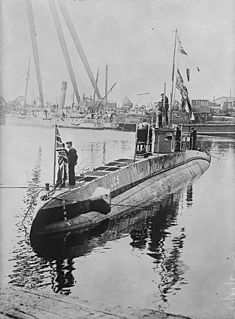
A frigate is a type of warship. In different eras, the roles and capabilities of ships classified as frigates have varied somewhat.

A submarine is a watercraft capable of independent operation underwater. It differs from a submersible, which has more limited underwater capability. The term is also sometimes used historically or colloquially to refer to remotely operated vehicles and robots, as well as medium-sized or smaller vessels, such as the midget submarine and the wet sub. Submarines are referred to as "boats" rather than "ships" irrespective of their size.
General Dynamics Electric Boat (GDEB) is a subsidiary of General Dynamics Corporation. It has been the primary builder of submarines for the United States Navy for more than 100 years. The company's main facilities are a shipyard in Groton, Connecticut, a hull-fabrication and outfitting facility in Quonset Point, Rhode Island, and a design and engineering facility in New London, Connecticut.

A submarine-launched ballistic missile (SLBM) is a ballistic missile capable of being launched from submarines. Modern variants usually deliver multiple independently targetable reentry vehicles (MIRVs), each of which carries a nuclear warhead and allows a single launched missile to strike several targets. Submarine-launched ballistic missiles operate in a different way from submarine-launched cruise missiles.

The Portsmouth Naval Shipyard, often called the Portsmouth Navy Yard, is a United States Navy shipyard in Kittery on the southern boundary of Maine near the city of Portsmouth, New Hampshire.

A ballistic missile submarine is a submarine capable of deploying submarine-launched ballistic missiles (SLBMs) with nuclear warheads. The United States Navy's hull classification symbols for ballistic missile submarines are SSB and SSBN – the SS denotes submarine, the B denotes ballistic missile, and the N denotes that the submarine is nuclear powered. These submarines became a major weapon system in the Cold War because of their nuclear deterrence capability. They can fire missiles thousands of kilometers from their targets, and acoustic quieting makes them difficult to detect, thus making them a survivable deterrent in the event of a first strike and a key element of the mutual assured destruction policy of nuclear deterrence.

The Soviet Navy was the naval warfare uniform service branch of the Soviet Armed Forces. Often referred to as the Red Fleet, the Soviet Navy made up a large part of the Soviet Union's strategic planning in the event of a conflict with the opposing superpower, the United States, during the Cold War period between the two countries. The Soviet Navy played a large role during the Cold War (1945-1991), either confronting the North Atlantic Treaty Organisation in western Europe or power projection to maintain its sphere of influence in eastern Europe.

The Mackerel-class submarines were a pair of experimental prototype submarines built just prior to World War II and launched in 1940 and 1941. The two submarines were similar in size and capability to the S-class submarines built at the end of World War I, and had been ordered to test the feasibility of using mass production techniques to build small submarines. Until at least 1940 it was thought that mass production of fleet submarines would be impractical, and in any case small submarines could provide area defense for submarine bases. Once it became apparent that there would be sufficient production of the more capable Gato-class submarines, interest in the design waned and no additional small submarines were ordered. Submarine production standardized during the war on the Gato class and its successors, the Balao and Tench-class submarines. In some references, the Mackerels are called the "M class".

The Shishumar-class submarines are diesel-electric attack submarines, currently in active service with the Indian Navy. These submarines are an Indian variant of the Type 209 submarines developed by the German yard Howaldtswerke-Deutsche Werft under the internal designation "Type 1500". The first two vessels were built by HDW at Kiel, Germany, while the remainder were built by Mazagon Dock Limited, at Mumbai, India, under a technology transfer agreement. The submarines were commissioned between 1986 and 1994. These submarines have a displacement of 1,660 tons when surfaced, a speed of 22 knots, and a complement of 40 including eight officers.

BAE Systems Submarines, is a wholly owned subsidiary of BAE Systems, based in Barrow-in-Furness, Cumbria, England, and is responsible for the development and production of submarines.

The Holland 602 type submarine, also known as the H-class submarine, was one of the most numerous submarines of World War I. The type was designed by the Electric Boat Co. of the United States, but most of the boats were built abroad: in Canada by the subsidiary of the British Vickers company and in British shipyards.
Friedrich Krupp Germaniawerft was a German shipbuilding company, located in the harbour at Kiel, and one of the largest and most important builders of U-boats for the Kaiserliche Marine in World War I and the Kriegsmarine in World War II. The original company was founded in 1867 but went bankrupt and was bought out by Friedrich Krupp. Krupp was very interested in building warships and in the time before the First World War built a number of battleships for the Kaiserliche Marine, including SMS Posen, SMS Prinzregent Luitpold, SMS Kronprinz, and SMS Sachsen. A total of 84 U-boats were built in the shipyard during the war. After the war it returned to the normal production of yachts and transports.

The JSC Admiralty Shipyards is one of the oldest and largest shipyards in Russia, located in Saint Petersburg. The shipyard's building ways can accommodate ships of up to 70,000 tonnes deadweight (DWT), 250 metres (820 ft) in length and 35 metres (115 ft) in width. Military products include naval warships such as nuclear and diesel-powered submarines and large auxiliaries.

Mazagon Dock Shipbuilders Limited (MDL), formerly called Mazagon Dock Limited, is a shipyard situated in Mazagaon, Mumbai. It manufactures warships and submarines for the Indian Navy and offshore platforms and associated support vessels for offshore oil drilling. It also builds tankers, cargo bulk carriers, passenger ships and ferries.

The British H-class submarines were Holland 602 type submarines used by the Royal Navy. The submarines constructed for the British Royal Navy between 1915 and 1919 were designed and built in response to German boats which mined British waters and sank coastal shipping with ease owing to their small size. The H class was created to perform similar operations in German waters, and to attack German submarines operating in British waters.

The D-class submarine was the Royal Navy's first class of submarines capable of operating significantly beyond coastal waters. They were also the first boats to be fitted with wireless transmitters. Ten were laid down between 1907 and 1910, though only 8 were completed as D-class boats. The final two hulls were completed as British E-class submarine.

The United States L-class submarines were a class of 11 submarines built 1914–1917, and were the United States Navy's first attempt at designing and building ocean-going submarines. At the time there was a significant gap in long-range submarine design compared with other major navies. The Group 2 L-boats designed by Lake Torpedo Boat Company were built to slightly different specifications from the other Group 1 L-boats and are sometimes considered a separate L-5 class.

Mykolayiv Shipyard is a major shipyard owned by state and located in Mykolaiv, Ukraine. In modern times, the shipyard has been most commonly referred to as Mykolayiv North Shipyard. Until 2017, it was known as the Shipyard named after 61 Communards.
The Italian submarine fleet of World War II was the largest in the world at the time, with 116 submarines. It saw action during the Second World War, serving mainly in the Mediterranean. During the conflict 88 submarines, some two-thirds of its total strength, were lost.

A coastal submarine or littoral submarine is a small, maneuverable submarine with shallow draft well suited to navigation of coastal channels and harbors. Although size is not precisely defined, coastal submarines are larger than midget submarines, but smaller than sea-going submarines designed for longer patrols on the open ocean. Space limitations aboard coastal submarines restrict fuel availability for distant travel, food availability for extended patrol duration, and number of weapons carried. Within those limitations, however, coastal submarines may be able to reach areas inaccessible to larger submarines, and be more difficult to detect.

















